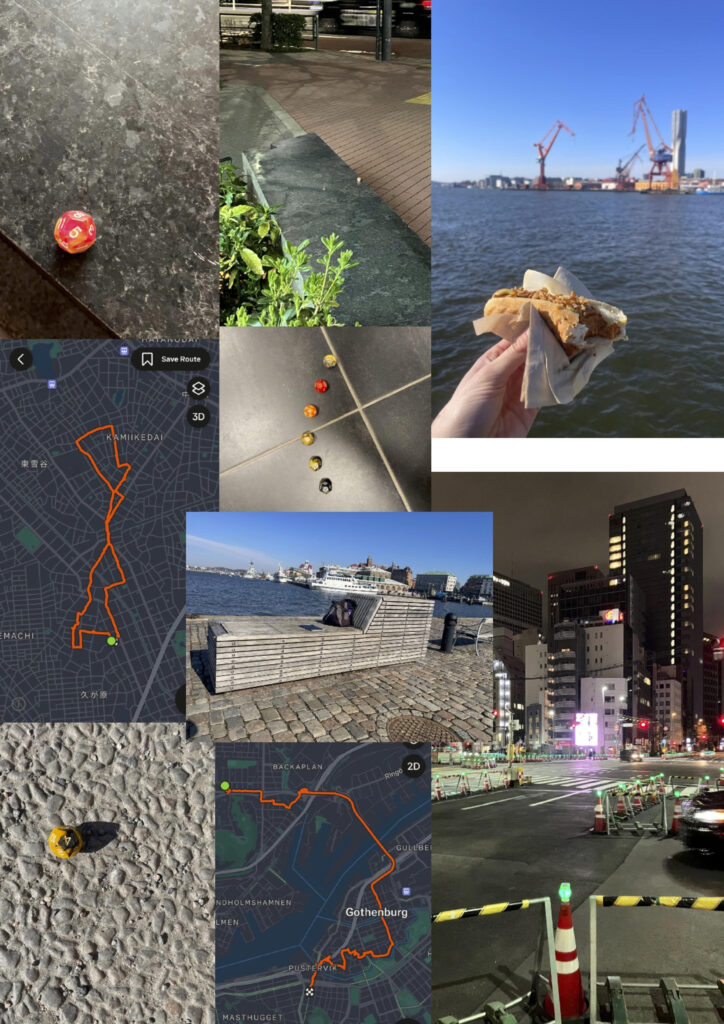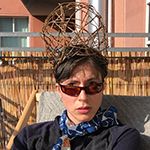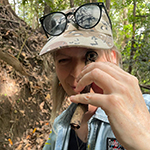OUR GAME

0. A history
How does one handle a long distance situation? Long distance is never easy and circumstances can make things worse. The two of us spent years long-distance in different countries on different continents with a time difference of 8 hours. This was extremely hard and got harder during COVID, when we couldn’t see each other for almost 15 months. How does one navigate something like this? For us: lots of texting, lots of phone calls, physical letters, reading stories and books to each other over voice message & phone, videochat. But one cannot be on the phone all the time and even less on videochat staring at the screen, especially with an 8h time difference; one person is going to bed when the other is in the middle of their day, and then wakes up as the other is going to bed. How to feel together at this distance in spacetime?
We needed something more active than a phone call, more a joint process than reading a text into the phone (though reading aloud is one of the coziest and most mutual activities we know of). We needed something to do together. When together in flesh we play a lot of board games of various kinds, games like backgammon and also more abstract games and ones we make ourselves. For this specific situation we made a game together that we could play from distance and played it, bringing ourselves into parallel space, translating the space of each of us into the space of the other, trying to bring ourselves close when physical closeness was not a possibility. This game is what we want to share here.
1. The game
Taking walks is fun and interesting. So many things to see, hear, smell, touch; so many new stimuli; so many opportunities to connect with the rest of the world. It’s especially fun with a friend or partner, especially just with one person – you show each other the things you notice, point them out, move bodies together through space, stop for a snack or a drink or to play a game of cards, jump on a bus or train and go somewhere. This pleasure is the basis for our game.
Every walk traces a path through spacetime. It runs along a trajectory in space and a trajectory in time. These kinds of trajectories can be mapped to each other and describe parallel spaces with similar paths but perhaps completely different characters. This means that two walks in two different spaces, while perhaps leading through totally different scenes, peoples, colors and smells, can still occupy the same amount of time and run along the same – or similar – trajectories that map to each other at some level of abstraction. These trajectories can also be constructed in parallel, jointly by the two moving points that are the loci of the two paths: that is, the two people taking the two walks that comprise those paths. Setting those trajectories is the game; moving along those trajectories, jointly and together, is how the game is played.
The game: to take walks together, connected by phone, making joint decisions about the path. Choose a starting location and make a call. Then walk through the space you are in and make decisions together about how to guide the path. In the city: when possible paths diverge, for example at each intersection (or at whatever intersections feel interesting), choose together what direction to go in. Left, right, straight. In our games the only rule is that we do not go backward; or perhaps this is just such an obvious point to the two of us that the idea of turning around never has come up. As you walk, observe what is around and talk about it, describe it, create a joint mental space from the two physically separate spaces you move in. At the end, you have had a walk together. You have drawn the same figure on two distinct maps of physical spaces. You have occupied the same slice of time with this activity. Ultimately, you have folded the map of spacetime and brought two distant spaces together into one via joint choice and joint attention. Somehow, despite being so far apart, you are together. This is the game.
There are various ways this game can be realized. In part, it depends on the kind of choices that are needed; this in turn depends on the space one is in. Different spaces have different granularities and different choice points. If one is in the city, choices involve intersections and directions, entering into spaces like shops or libraries, climbing stairs or not, boarding (or not) a bus or train.
Elsewhere the choice points might be quite different. In the forest or at the sea the choices are not so discrete: one can always choose to move in any direction when there are no existing roads to choose between. Thus the game requires that both (or all, if there are more than two) players are in spaces with similar option sets: if one player can move in any direction but the other only left or right, it is hard to choose together. In this kind of situation, one must at least find a way to make the two kinds of spaces similar in a way that allows a joint decision. This is easier to do mapping from the city to the forest: one only needs to impose a discrete set of choice points on the continuous space of the forest in a way that reconstructs the options available in the city, for instance letting any path leading leftward in the forest be analogous to the city player’s left turn. (This probably also says something about the kinds of freedom that are accessible in these kinds of spaces as well: we always have choices, but the city channels those choices into much more specific directions.)
2. A playthrough
We met on Thursday, March 20, 2025: the spring equinox, though the celestial did not play a role in our game this time. Karina in Gothenburg at 11am, Seraphine in Tokyo at 7pm. We chose to let dice determine our path. Seraphine had a 12-sided die in her pocket and Karina picked one up at the beginning of the game. 12 sides is a good number for a city-walk game: it gives a clear procedure for choices between two options (1-6 vs 7-12, e.g. left turn vs right turn), three options (left, forward, right: 1-4, 5-8, 9-12), for four options (left, forward, right, back), or for 6 (when presented, say, with multiple flights of stairs, station exits, doors, menu items when ducking into a bar). This is very functional. For choice points with other numbers, one must develop strategies.
K I start off at the scifi bookstore at Kungsgatan in Gothenburg, over the phone selecting a 12-sided die together. It is still winter time here, meaning Seraphine and I are on 8 hours time difference. My noon is past her dinner time. It’s always difficult, or maybe it should be difficult to find a time which works for both of us, but we always manage somehow. We walk together through familiar places, letting each other and die rolls decide the way. Talking away like always, we stroll through the streets. Sometimes decision points leave us walking paths we don’t necessarily want to walk. This part is interesting for me, and is something that is pivotal to a joint activity, both leaning on and leading each other, sometimes by choice, sometimes by chance.
The landscape I see is blended together with the descriptions of Seraphine’s scenery which I receive through my earbuds. The result is a portrait of a city we could only experience except through this medium. It is both night and day, temperatures are both below and above 10 degrees, smells, sounds and textures fuse and produce fluky new profiles, sketching out our joint hour in this liminal space. When Serpahine stops in to charge her phone and have a drink, I stop at the convenience store and have a hotdog. I fumble on a bench and manage to drop my phone through the boards of the box which makes up the bench. After slight panic I manage to pull it out by slipping my notebook in between the boards and using it as leverage point. We keep talking until our phones run out of battery.
S Karina called me just as I stepped off the train in Shinbashi. I almost never go to this area: I associate it mostly with basic bars and restaurants catering to the after-work businessman world. These days it’s tons of chain izakaya where it used to be hostess bars and trashy neon, but it still has small back streets with old bars which actually look cute. This I learned after I left the train. The space immediately around the station is very noisy and while Karina made their way to the game store I walked straight down a long small street, past lots of bars and lots of touts trying to get people into their bars. The street got quiet and dark and this was nice. A cold night, not windy; I wore many layers and tights and felt warm and happy. I rolled my die to help decide which to get on the Swedish side. Then we started to play for real.
We walked, rolled dice, made choices. The night was cool and slick like silk. We were messy and unprepared, both our phones low battery, which meant Karina bought me a drink when I stopped at some terrible bar to charge mine a bit. The dice roll resulted in me ordering a bottled beer half frozen in some freezer, which was interesting as I would otherwise never ever have ordered it, especially on a chilly evening like this one. I rolled my die on the pavement, on benches, bouncing the die off walls, taking photos of the die on the ground and forgetting to pick it up twice and having to run back. The photo and the game and the conversation more present than my attachment to the object. The low-charge situation though was difficult and it felt hard to stay completely focused. Then finally my phone was almost dead and I said “I worry my phone will die now” and in that moment it died. Game over for the night.
4. Variants
This game can be changed up in many ways: there are many things one can do. In our play through above we let chance decide our walk by rolling dice. There are of course other options, even just in path choice.
Here are some. One can add stimuli and actions to the game and its process. For instance, one could play a variant of the classical car game while traversing the path, where each player looks for some specific item (something green, a white horse or car, a constellation of cracks that form a particular rune, a vine or road that doubles back on itself). One could build something with materials found along the way; we played like this before ourselves, during COVID, selecting three objects from the trash or just discarded on the road, building something with them and giving it a story. The players could add a new creative element by running metaphorical mappings of the objects along the paths traversed, putting them into a story or transforming the walk itself into a fairy tale. Ultimately, these moves are all about situating the pathbuilding game in a bigger gamespace which allows for richer and deeper transformations and building things together. The space of games of this kind is very large and they are very fun to play. The big question they raise: what does it mean to be together? How does one build things together, in this case temporary paths and stories and assignments of meaning? Maybe: the pathbuilding game is itself a model of a relationship, and its variants are too. In this sense, this game that we made when we had to be far apart in space brought us even closer together. We hope it can do the same for others, and also that it is fun to play.

Karina prefers to spend time in bogs, forests and ditches. On a quest to tie together things and non-things. Spends most of her time making, thinking about and playing with string. Currently twisting fibers of hemp and nettle. She defeats the rule of the game; lucky both at cards AND in love! Looking to play in Barcelona. Contact: [email protected]

Seraphine cares about words, birds, stones and spells, and also other things. She is a gamer for many years, but not on screens, or not mostly. Her favorite games involve chance, choice and manipulation. She would like to make things better. One day she will figure out how exactly magic works. Then: watch out, or, alternatively, don’t. She lives between Barcelona, Berlin and Tokyo. Contact: [email protected]

 BACK TO ISSUE
BACK TO ISSUE